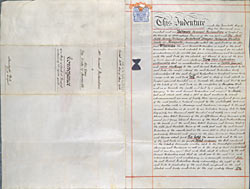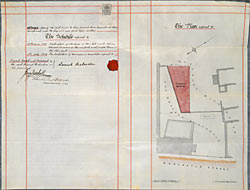Grant or Conveyance
Up to the 1830s there were a number of methods which could be used to transfer land. Final concords and common recoveries were abolished by the Fines and Recoveries Act of 1833. The Conveyance by Release Act of 1841 replaced the lease and release with just a statutory release. Then in 1845 the Real Property Act abolished releases and feoffments, allowing freehold land to be conveyed by a simple grant only. By the later nineteenth century, this deed was generally referred to as a conveyance.
Purpose
Sale of real property (land or buildings) from one party to another, for a monetary consideration.
Features of grants or conveyances
- 1845-1925
- large up to 1881, then replaced by smaller folded folios
- written on parchment
- written in English
- indenture (wavy top edge), replaced by deed poll (straight top edge) later in the nineteenth century
- seal
Important words and phrases
The Conveyancing Act of 1881 simplified the form of a conveyance. Whereas deeds had previously been very wordy and written on numerous sheets of parchment, conveyances from this time on became smaller and more manageable. They also became more standardised, with a number of 'model clauses' developed. They are generally much easier to read and understand than earlier title deeds.
Conveyances include the phrase:
'as beneficial owner hereby conveys...'
The financial consideration is given in full, and the property is conveyed for ever.
Example
Ne 6 D 2/42/317 - Conveyance from Mr Samuel Richardson to Henry P.A.D. Pelham-Clinton, 7th Duke of Newcastle under Lyne of a strip of land at Tuxford, Nottinghamshire; 20 May 1901


View this deed: front | reverse | plan | description
This is a typical example of a conveyance from the period 1881 to 1925. We know it is a conveyance because of the following characteristics:
- Although the deed is made between two or more parties, it is a 'deed poll', that is the top of the deed is cut in a straight line. In the previous century it would have been an indenture, but the format of deeds was simplified at the end of the nineteenth century
- It begins with the words 'This Indenture...'
- It includes the phrase 'as beneficial owner conveys'
- The consideration is stated in full
- The land is transferred in fee simple for ever
This transcription of the important parts of the conveyance has been broken down into the standard sections common to most deeds from the early modern period onwards.
Date
This Indenture made the Twentieth day of May One thousand nine hundred and one
Parties
Between Samuel Richardson of Tuxford in the County of Nottingham Farmer of the one part and The Most Noble Henry Pelham Archibald Douglas Pelham Clinton Duke of Newcastle (hereinafter called the said Duke) of the other part
Operative Parts or 'Testatum'
Whereas the said Samuel Richardson is seized of the land hereinafter described and intended to be hereby conveyed for an estate of inheritance in fee simple free from incumbrances and has contracted with the said Duke for the absolute sale thereof to him at the price of Twelve pounds and nine shillings Now this Indenture witnesseth that in consideration of the sum of Twelve pounds and nine shillings to the said Samuel Richardson now paid by the said Duke (the receipt whereof the said Samuel Richardson hereby acknowledges) He the said Samuel Richardson as beneficial owner hereby conveys unto the said Duke
Parcels
All that plot or strip of land situtate in Tuxford aforesaid bounded on or towards the North and West by part of the Estate of the said Duke in the occupation of Sampson Weeds and on or towards the South and East by a garden or Orchard belonging to the said Samuel Richardson and occupied by Joseph Gale and which said strip or plot of land contains by recent admeasurement an area of Eighty three square yards and forms part of the said Garden or Orchard occupied by the said Joseph Gale and was (together with a Messuage and Brewhouse) conveyed to the said Samuel Richardson in fee simple by an Indenture bearing date the Fifth day of July One thousand eight hundred and eighty nine and made between John Robert Bowman of the first part William Henry Bowman of the second part George Edward Bowman of the third part Frederick Bowman of the fourth part the said John Robert Bowman and Samson Weeds of the fifth part Charlotte Pearce of the sixth part and the said Samuel Richardson of the seventh part as the same plot or strip of Land is now particularly delineated and shewn on the plan drawn on these presents and thereon coloured pink
'Habendum'
To hold the same unto and to the use of the said Duke in fee simple
Covenants, Conditions and Provisos
And whereas the deeds mentioned in the Schedule hereunder written relate to the hereinbefore mentioned Messuage and Brewhouse as well as to the strip of Land hereby conveyed and it has been agreed that such deeds shall be retained by the said Samuel Richardson and that he shall give to the said Duke such acknowledgment and undertaking as is hereinafter contained Now the said Samuel Richardson hereby acknowledges the right of the said Duke to production of the said Deeds comprised in the said Schedule and hereby undertakes for the safe custody thereof
The Schedule referred to
16th June 1871 Indenture of Mortgage of this date made between Edward Bowman of the one part and Joseph Baines of the other part
5th July 1889 The Indenture of Conveyance hereinbefore referred to
Witnesses
In witness whereof the said parties to these presents have hereunto set their hands and seals the day and year first above written [signature of Samuel Richardson]
Signed Sealed and Delivered by the said Samuel Richardson in the presence of [signature of George Marshall, solicitor, East Retford]
Endorsements
None, except for 'The Plan referred to' [coloured plan of the premises, produced by the Newcastle Estate Office, Worksop]; and a description of the document for reference.
Next page: Leasehold land